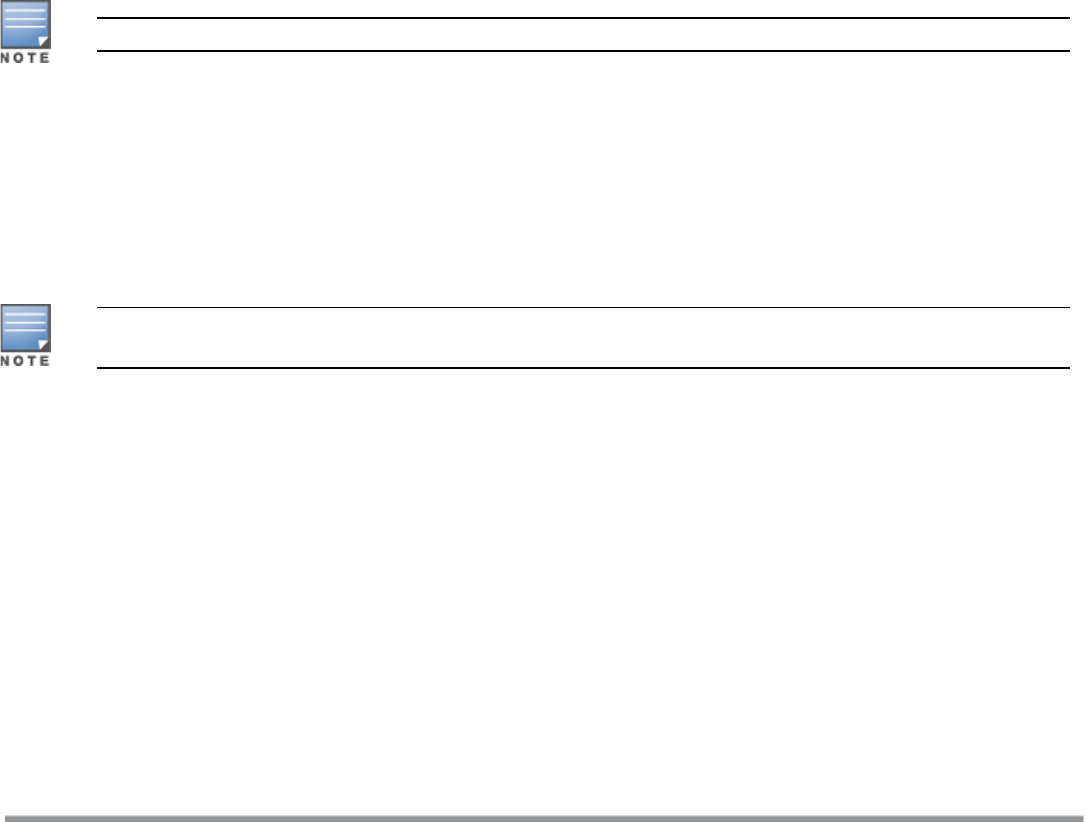Concept Guide
Table Of Contents
- About this Guide
- About Instant
- Setting up a W-IAP
- Automatic Retrieval of Configuration
- Instant User Interface
- Initial Configuration Tasks
- Customizing W-IAP Settings
- Modifying the W-IAP Host Name
- Configuring Zone Settings on a W-IAP
- Specifying a Method for Obtaining IP Address
- Configuring External Antenna
- Configuring Radio Profiles for a W-IAP
- Configuring Uplink VLAN for a W-IAP
- Changing the W-IAP Installation Mode
- Changing USB Port Status
- Master Election and Virtual Controller
- Adding a W-IAP to the Network
- Removing a W-IAP from the Network
- VLAN Configuration
- IPv6 Support
- Wireless Network Profiles
- Configuring Wireless Network Profiles
- Configuring Fast Roaming for Wireless Clients
- Configuring Modulation Rates on a WLAN SSID
- Multi-User-MIMO
- Management Frame Protection
- Disabling Short Preamble for Wireless Client
- Editing Status of a WLAN SSID Profile
- Editing a WLAN SSID Profile
- Deleting a WLAN SSID Profile
- Wired Profiles
- Captive Portal for Guest Access
- Understanding Captive Portal
- Configuring a WLAN SSID for Guest Access
- Configuring Wired Profile for Guest Access
- Configuring Internal Captive Portal for Guest Network
- Configuring External Captive Portal for a Guest Network
- Configuring Facebook Login
- Configuring Guest Logon Role and Access Rules for Guest Users
- Configuring Captive Portal Roles for an SSID
- Configuring Walled Garden Access
- Authentication and User Management
- Managing W-IAP Users
- Supported Authentication Methods
- Supported EAP Authentication Frameworks
- Configuring Authentication Servers
- Understanding Encryption Types
- Configuring Authentication Survivability
- Configuring 802.1X Authentication for a Network Profile
- Enabling 802.1X Supplicant Support
- Configuring MAC Authentication for a Network Profile
- Configuring MAC Authentication with 802.1X Authentication
- Configuring MAC Authentication with Captive Portal Authentication
- Configuring WISPr Authentication
- Blacklisting Clients
- Uploading Certificates
- Roles and Policies
- DHCP Configuration
- Configuring Time-Based Services
- Dynamic DNS Registration
- VPN Configuration
- IAP-VPN Deployment
- Adaptive Radio Management
- Deep Packet Inspection and Application Visibility
- Voice and Video
- Services
- Configuring AirGroup
- Configuring a W-IAP for RTLS Support
- Configuring a W-IAP for Analytics and Location Engine Support
- Managing BLE Beacons
- Clarity Live
- Configuring OpenDNS Credentials
- Integrating a W-IAP with Palo Alto Networks Firewall
- Integrating a W-IAP with an XML API Interface
- CALEA Integration and Lawful Intercept Compliance
- Cluster Security
- W-IAP Management and Monitoring
- Uplink Configuration
- Intrusion Detection
- Mesh W-IAP Configuration
- Mobility and Client Management
- Spectrum Monitor
- W-IAP Maintenance
- Monitoring Devices and Logs
- Hotspot Profiles
- ClearPass Guest Setup
- IAP-VPN Deployment Scenarios
- Acronyms and Abbreviations

239 | IAP-VPN Deployment Dell Networking W-Series Instant 6.5.1.0-4.3.1.0 | User Guide
l Branches—The number of IAP-VPN branches that can be terminated on a given controller platform.
l Routes—The number of L3 routes supported on the controller.
l L3 mode and NAT mode users—The number of trusted users supported on the controller. There is no
scale impact on the controller. They are limited only by the number of clients supported per W-IAP.
l L2 mode users—The number of L2 mode users are limited to 128,000 for W-7220 or W-7240 Controllers
and 64,000 across all platforms.
IAP-VPN Forwarding Modes
The forwarding modes determine whether the DHCP server and default gateway for clients reside in the
branch or at the datacenter. These modes do not determine the firewall processing or traffic forwarding
functionality. The VC enables different DHCP pools (various assignment modes) in addition to allocating IP
subnets for each branch.
The VC allows different modes of forwarding traffic from the clients on a VLAN based on the DHCP scope
configured on the W-IAP.
For the IAP-VPN deployments, the following forwarding modes are supported:
l Local mode
l L2 Switching mode
l L3 routing mode
The DHCP scopes associated with these forwarding modes are described in the following sections.
Ensure that VLAN 1 is not configured for any of the DHCP scopes as it is reserved for a different purpose.
Local Mode
In this mode, the W-IAP cluster at that branch has a local subnet and the master W-IAP of the cluster acts as the
DHCP server and gateway for clients. The local mode provides access to the corporate network using the inner
IP of the IPsec tunnel. The network address for traffic destined to the corporate network is translated at the
source with the inner IP of the IPsec tunnel and is forwarded through the IPsec tunnel. The traffic destined to
the non-corporate network is translated using the IP address of the W-IAP and is forwarded through the
uplink.
When the local mode is used for forwarding client traffic, hosts on the corporate network cannot establish
connections to the clients on the W-IAP, because the source addresses of the clients are translated.
Local, L2 Mode
In this mode, the W-IAP cluster at that branch has a local subnet and the master W-IAP of the cluster acts as the
DHCP server. The default gateway is located outside the W-IAP and the network address for the client traffic is
not translated at source. In the Local, L2 mode, access to the corporate network is supported only in a single
W-IAP cluster. The traffic to the non-corporate network is locally bridged.
Local, L3 Mode
In this mode, the network address for traffic destined to the corporate network is translated at the source with
the inner IP of the IPsec tunnel and is forwarded through the IPsec tunnel. The traffic destined to the non-
corporate network is routed.










